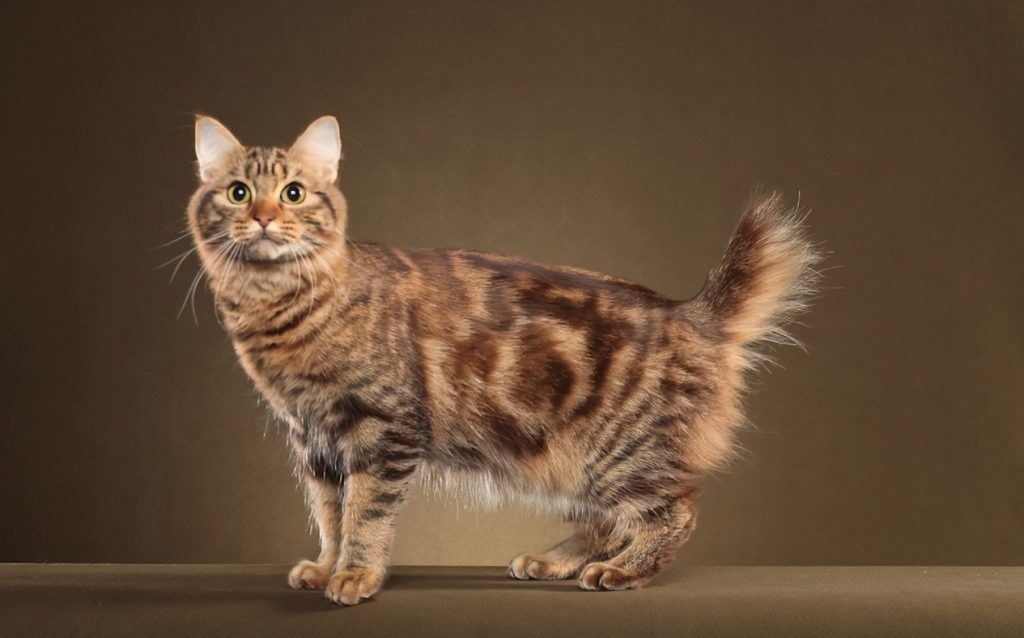The American short-tailed cat is is a mammal of the lynx genus of the cat family, whose distinguishing feature is its short tail, which can be seen erect when it is in a state of alertness, and ideally has no curved tail. Its body size is medium or large, with a wedge-shaped head, broad and strong, with large almond-shaped eyes. The coat is double-layered, one medium-length and dense, and one medium-length long-haired coat. The coat is waterproof and flexible, and it walks with the demeanor of a wildcat.
The American Short-tailed cat is native to the United States and attracts attention for its beautiful musculature and robust appearance. American Short-tailed cats are cute, friendly, intelligent, and share the same qualities as dogs – they are loyal to their owners and can adapt very quickly to busy or quiet environments. [2] The American Short-tailed cat takes 2-3 years to reach sexual maturity. And its long coat is not prone to tangles and only needs moderate grooming.
The American Short-tailed Cat is a new member of the cat family, and its popularity is growing by the day, and it is one of the CFA accepted breeds.
Appearance Characteristics
The adult male American Short-tailed cat is 0.7-1.2 meters in total length, averaging 0.9 meters, includes a 10-18 cm long tail, stands 36-38 cm tall at the shoulder, and generally weighs 7-14 kg. Females weigh an average of 9 kilograms. Short-tailed cats are muscular and have longer hind limbs than front limbs. At birth, the short-tailed cat weighs about 280-340 grams and is 25 centimeters long. It can grow up to 4.5 kilograms in the first year of life. The short-tailed cat is like other species of the lynx genus, but is on average smaller. Its fur varies and is generally fawn to grayish brown with black markings on the body, forelimbs and tail. Its round spots can be used for camouflage. The tips of the ears are black with short tufts of hair. The lips, cheeks and belly are generally beige. Short-tailed cats in the desert Southwest have lighter colored fur, while those in the northern forests are darker. Kittens are born already furred and spotted. A few short-tailed cats with melanism have been found in Florida. They are black, but may still retain spots. The short-tailed cat’s face looks wide due to the fur under the ears. Its fur is easily damaged, but the hair is long and dense. The nose is pink and the face, sides and back are gray, yellowish red or maroon. The eyes are yellow while the pupils are black. The pupils are long at the top and bottom and dilate in the evening to get the most light.
The short-tailed cat, also known as the red lynx and the North American bobcat, is mainly found in southern Canada to northern Mexico, including most of the United States. The short-tailed cat is a highly adaptable predator that inhabits woodlands, semi-deserts, cities and swamps.
Habits
Short-tailed cats are highly adaptable. They prefer to live in deciduous, ponderosa pine or mixed woodlands, but are not as dependent on forests as other lynx species. They can range from wet swamps to rugged mountains. They can build dens near farmland, and its spots can be camouflage if it is in rock gaps, swamps, or forests. Short-tailed cats are dawn animals, mainly at dawn and dusk. They are active from three hours before sunset until about midnight, then again from just before dawn to three hours after sunrise. Each night they move 3-11 kilometers along their habitat paths. This behavior changes seasonally, as they regulate their prey in winter and become active during the day. Short-tailed cats can go for long periods without eating, but will eat constantly when prey is abundant. When food is scarce, they will hunt larger animals in order to supply their needs later. Short-tailed cats prey on animals of different sizes and will change their hunting methods accordingly. For small animals, such as rodents, squirrels, birds, fish and insects, short-tailed cats will go to places where prey is abundant, lie down and wait and ambush the prey. For larger animals, such as rabbits and hares, it will stalk its prey until it is within 6-20 meters and begin to pursue it. It will also hunt larger animals such as foxes, minks, weasels, small dogs and domestic cats. Adult short-tailed cats’ natural predators include cougars and gray wolves, in addition to humans, and they will also kill each other. The natural enemies of kittens include owls, hawks, coyotes, foxes and adult short-tailed cats. When there is a lack of prey, it is difficult for kittens to grow into adult short-tailed cats.
Breeding
The gestation period of short-tailed cats is 60-70 days, and they are born from April to May, with about 1-6 cats in each litter, usually 2-4 cats. Sometimes the second litter is born as late as September. Females usually give birth in confined places such as tiny burrows or tree holes. The kittens will open their eyes on the 9th-10th day and begin to explore their surroundings after about 4 weeks and will be weaned after two months. They will begin to go outside with their mother after the 3rd-5th month. They will hunt on their own by winter of their first year and will soon be on their own. Kittens have been observed in Michigan still with their mothers as late as spring. Short-tailed cats generally live 6-8 years, with a few reaching 10 years of age. The longest-lived short-tailed cat in the wild is 16 years old, and the longest-lived cat in captivity is 32 years old.
Distribution
There are 12 subspecies of short-tailed cats, distributed in southern Canada, through the United States, and south to Oaxaca, Mexico. The distribution map is like a bag shape, with only the Midwestern and part of the Northeastern United States, including southern Minnesota, eastern South Dakota, Iowa, and most of Missouri, being free of them. Although they are believed to be extirpated from western New York and Pennsylvania, there are still sightings or dead bodies.

Subspecies Classification
There are 12 known subspecies of short-tailed cats:
1. Named subspecies (L. r. rufus): distributed in the eastern and midwestern United States.
2. L. r. gigas: distributed from northern New York to Nova Scotia and New Benz domain.
3. Florida subspecies (L. r. floridanus): distributed in the southeastern U.S. and the interior of the Mississippi Valley, up to southwestern Missouri and southern Illinois.
4. L. r. superiorensis: occurs in the region west of the Great Lakes, including upper Michigan, Wisconsin, southern Ontario, and most of Minnesota.
L. r. baileyi: occurs in the southwestern United States and northwestern Mexico.
6. California subspecies (L. r. californicus): distributed from western California to the Sierra Nevada.
7, L. r. escuinipae: distribution in central Mexico, along the west coast of South Sonora to the north.
8, L. r. fasciatus: western Cascades of Oregon and Washington, northwestern California, and southwestern British Columbia.
9, L. r. oaxacensis: occurs in Oaxaca
10. L. r. pallescens: occurs in the northwestern United States and southern British Columbia, Alberta, and Saskatchewan.
11. L. r. peninsularis: in Baja California.
12. L. r. texensis: western Louisiana, eastern Texas, south-central Oklahoma, and southern Tamaulipas, Nuevo Leon, and Coahuila.
Population Status
The short-tailed cat is listed in Appendix II of the Convention on International Trade in Endangered Species of Wild Fauna and Flora (CITES), which means that it is not in danger of extinction, but its hunting and sale must be monitored. The short-tailed cat is regulated in the three countries where it is distributed. According to a 1988 estimate, the number of short-tailed cats in the United States ranged from 700,000 to 1,500,000, with an increasing trend every year. Therefore, the United States has requested that short-tailed cats be removed from the Convention. The number of short-tailed cats in Canada and Mexico is also stable. The World Conservation Union (IUCN) classifies short-tailed cats as not at risk, which shows their relatively wide distribution, but there is no clear statistics in southern Mexico. Short-tailed cats are endangered in the states of Ohio, Indiana and Iowa. In 1999, they were removed from the endangered list in Illinois, and hunting restrictions were lifted in Pennsylvania. Short-tailed cats also declined in New Jersey in the 19th century, mainly because commercial and agricultural development reduced their habitat, and were listed as endangered in that state in 1991.L. rufus escuinipae, a subspecies of L. rufus in Mexico, was once considered endangered, but was delisted in 2005. Short-tailed cats are killed for their fur and movement, but manage to remain in numbers. Kittens are more vulnerable due to their need for maternal care. In the 1970s and 1980s, they were hunted heavily due to the rising value of their fur, but the price dropped sharply in the early 1990s. Half of the mortality rate of short-tailed cats is due to regulated hunting, so their numbers drop dramatically in the winter when hunting is open.




